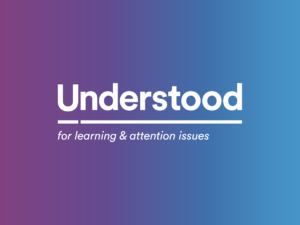
Bob Cunningham is the advisor-in-residence on learning and attention issues for Understood.
1. Cunningham’s Interest In Learning And Attention Issues Was Inspired By Students His First Year Teaching: Though Bob Cunningham has been with Understood since the organization’s inception, his interest in helping students with learning and attention issues dates back to his very first year of teaching high school social studies in southern Texas. “They were kids who were great to have in class,” Cunningham said.
“They were always up for discussion, always up for conversation, had great ideas, great insight…they could participate in every way, but when they turned in written work, it was really kind of poor quality. And as a new teacher, I could not make heads or tails out of that; I had no idea as to what was going on.”
Cunningham said he started putting in extra time with the students, working with them after school and at lunch. As he got to know them more, he said he continued to be impressed with how bright and capable they were, but equally “continued to be shocked by how much they struggled with the reading and the writing.”
“It just didn’t fit for me,” he said.
Cunningham eventually brought up his concerns with his principal, who told him those students had learning disabilities — a new concept for the first-time teacher.
“I was like, ‘What’s a learning disability?'” Cunningham recalled. “So it was really those kids who prompted me to then switch from a high school social studies teacher to an administrator.”
2. New Teachers Aren’t Feeling Fully Prepared To Teach Things Like Reading Right Out Of College: When first-year teachers step into the classroom, particularly those who teach general education, many are reporting a lack of confidence in feeling prepared to meet the needs of diverse learners, Cunningham said.
“Teachers don’t feel they know enough, or that they don’t have the tools at their disposal to work with kids with dyslexia, or with attention deficit, or a number of other learning disabilities,” Cunningham said.
That causes teachers to struggle with those students, an outcome Cunningham said often is about a teacher’s sense of self-efficacy.
“Teachers want to feel able to make a difference in the lives of the kids they’re working with, and when they don’t feel that way, it’s really discouraging, really frustrating,” he said. “I see it day in and day out in the work that I do…and I encountered it when I was a teacher.”
Things like teacher preparation programs and professional development courses then become especially critical resources for boosting educators’ confidence and skills, Cunningham said. And, learner variability and diverse learners need to be part of that training, he added.
“We need to have teachers come out of teacher preparation programs, whether it’s the colleges of education, or whether it’s more non-traditional approaches,” he said.
For that reason, the National Center for Learning Disabilities is also currently exploring an initiative geared toward general educators, Cunningham said.
“We want organizations to really think about these kids not as problematic, we want them to be seen for what they bring to your class and the fact that your class is a better place for having kids with learning differences,” Cunningham said. “We want them to be valued as part of the community, but in order to be valued, teachers have to have the tools, have the knowledge, and feel like they can really be effective with these kids.”
3. But Too Many Competing Teaching Strategies Cause “Analysis Paralysis” — Teachers Need ‘High-Impact’ Strategies And Coherent Development: While many school districts do offer teachers access to professional development courses and trainings, a common mistake is that teachers often then become inundated with so many strategies and so much information that it leads to becoming “paralyzed” from being able to effectively understand, apply and evaluate those tools.
“You have schools who get ‘analysis paralysis’ because they analyze each subgroup so intensely and try to choose different programs and approaches for each one,” he said. “One thing we know about professional development for teachers is that most teachers actually feel like they get enough professional development — the problem is the professional development does’t have any coherence to it. They get isolated professional development that’s not related to everything else that they’re doing or other professional development that they have, so they just become overwhelmed with everything that’s being thrown at them.”
“Districts that are really successful adopt coherent approaches to instruction and to professional development; that idea of coherence is super important,” Cunningham said.
What Cunningham suggests to districts is utilizing “high-impact” strategies that can speak to all types of students with varying learning abilities.
“We know where the common threads are, so just pull them,” he said. “It’s those high-impact strategies. Teachers have to make so many decisions throughout the course of the day, so you really need to know: What are your highest impact strategies? What kinds of strategies are going to move the needle, move it fastest and move it furthest? Those are the ones that you double down on. That’s the kind of preparation teachers need, and those are the kind of tools that teachers need.”
Identifying the high-impact methods that work in the classroom then begets other benefits, such as consistency, that particularly help engage students with learning and attention issues, Cunningham said. Providing teachers and students with that framework is key.
“We need to provide teachers with frameworks that make sense,” he said. “How can they be confident in the decisions they’re making, how can they be consistent? We know that kids with learning and attention issues benefit from consistency, we know they benefit from explicit instruction, we know they benefit from multiple models, we know they benefit from metacognitive instruction, we know that teaching them literacy through multi-sensory language structure approaches works.”
4. Multi-Sensory Instruction, Early Intervention And Concepts Like Orton-Gillingham Work For All Students: When it comes to identifying those high-impact strategies, Cunningham research points to what has been proven to work — the struggle then comes to spread awareness on those effective methods.
“We know what works for all kids, not just those with learning or attention issues,” he said. “Multi-sensory structured language instruction that is sequential and directly taught works, and we also know that it works for every other kid in the classroom.”
Cunningham said one common mistake he sees school districts making is investing in strategies that, while possibly more “comfortable” for general education teachers, are “inappropriate” for the very purpose they seek to serve — reaching students with learning or attention issues.
“If [school districts] would get the multi-sensory structured approaches, they would be able to reach all the kids who need literacy and reading instruction,” he said. “It’s kind of a situation where we know [districts] have choices, so please choose this one because it will work for everyone, not just some.”
In addition to the multi-sensory approach, Cunningham said practices like comprehensive early childhood education screening and early intervention are crucial pieces of a complex picture and provide benefit to all students.
“We know from research how important early intervention is, so if you’re going to put your next dollar somewhere, early intervention is a great choice,” Cunningham said. “The research is clear, the anecdotes are clear: this is the stuff that works.”
5. Third-Grade Reading Laws Are Well-Intentioned, But Fail To Address Roots Of A Complex Problem: While those who design and implement state reading laws are well-intentioned — such as Michigan’s “Third Grade Guarantee,” which says students must read read proficiently by the end of third grade or be left behind — they fail to address the true causes and treatments for low literacy rates, Cunningham said.
“The people who develop these laws, I do believe they are very well-intentioned, and they’re fed up with kids not being able to learn and perform adequately, and the outcomes not being there for the students,” he said. “I think a lot of times though those are unrealistic.”
While it’s right for districts, parents, educators and students to strive for high expectations, especially from students with learning disabilities, those assessments and benchmarks need to make sense and be realistically achievable, Cunningham said.
“It’s incredibly important that we maintain high expectations, but you also have to approach things practically – there is a big, big space between zero and proficient, and then there are smaller spaces between being proficient and being most proficient,” he said. “These laws that are one-size-fits-all don’t really take that into consideration. It almost assumes that everybody starts from the same place, and we know that’s not true.”
Rather than meeting arbitrary benchmarks, growth over time is more important, Cunningham said.
“What’s more important to me is saying: here is the kid you’re getting, what are you doing with that kid from where he or she is currently at to the end of the time period that we’re talking about?” he said. “What you want to see is high expectations and good growth, which is more important to me than some arbitrary bar that’s been set. If anyone in Michigan wants my advice, it’s those high-leverage strategies where you want to be doubling down on.”

Understood.org is a free online resource for parents and educators.
Ultimately, Cunningham said his job is about helping people: students, teachers, parents, administrators, school districts and more.
“People motivate me to do this,” he said. “Everybody cares about this. I don’t think there’s any way you can be in this field and not be motivated on a daily basis by the people you encounter; you can see the need for the kind of work that we do.”
Understood.org has especially become a prudent tool for those groups, and Cunningham said he encourages anyone seeking information or resources to utilize the organization’s information online.
“The reason that we launched Understood is to help parents be better informed, better advocates for their kids,” he said. “We know a knowledgeable and empowered parent and teacher makes all the difference in a kid’s life, these are all critical things.”
Learn more about how the Institute for Multi-Sensory Education is using its high-impact strategies to transform districts around the country.
